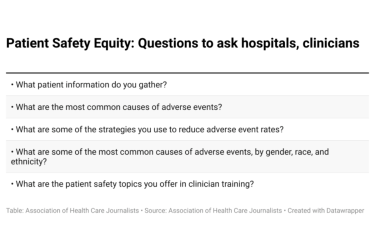
The COVID pandemic drew public attention to an issue already well known in health care circles: the challenges hospitals face in retaining their nursing staff, which can affect medical care. Research shows lower nurse-patient ratios mean better patient outcomes, journalist Sarah DiGregorio explained in a Sept. 28 AHCJ webinar. DiGregorio reviewed some of the key research she found in reporting for her forthcoming book, “Taking Care: The Revolutionary Story of Nursing,” due out in May.
To help reporters dig into this issue, this blog post contains a brief background section and then provides links and summaries of a few studies and then a resources section.
Background on nurse pay
The issue of nurse pay and retention flashed into the news cycle during the pandemic, with hospitals having to pay higher-than-average salaries for temporary, or travel, nursing staff. “Need a Covid nurse? That’ll be $8,000 a week,” was the title of a November 2020 Kaiser Health News story.
Reading beyond the headlines showed that money alone was not driving nurses to change jobs. In that article, Markian Hawryluk and Rae Ellen Bichell reported the story of Claire Tripeny, a Colorado intensive care nurse who left a job she loved for a temporary contract in New Jersey. That job paid “about $5,200 a week, and with a contract that required adequate protective gear,” Hawryluk and Bichell reported.
Tripeny told Kaiser Health News that her employers in Colorado had told the nursing staff “to ‘suck it up’ as they struggled to care for six patients each and patched their protective gear with tape until it fully fell apart. The $800 or so a week she took home no longer felt worth it.”
DiGregorio had been interviewing nurses for her book before the pandemic took hold.
“One thing that came up again and again and again is that nurses are hindered in their work by unsafe nurse staffing, by short staffing in hospitals,” DiGregorio told AHCJ.
In March, DiGregorio wrote an article that appeared in the Washington Post, “Hospitals desperately need staff. But capping travel nurses’ pay won’t help.”
“In interviews, nurses from across the country have told me many variations of a shared story: Working conditions, which had never been ideal in the first place — because of a lack of support staff and high patient-to-staff ratios, among other factors — have dramatically deteriorated. Nurses have been asked to work to the edge of their abilities; they fear for patient safety,” DiGregorio wrote.
Journalists covering their local hospitals should consider digging into the topic of nurse staffing beyond stories focused on the cases of high weekly pay during the pandemic. The American Nurses Association (ANA) notes that its members “are under immense stress and feel the full weight of an overburdened, poorly functioning health care system.”
In an August 2021 opinion article for the New York Times, “Nurses Deserve Better. So Do Their Patients,“ Linda Aiken, Ph.D., R.N., highlighted some of the challenges the profession faces. Aiken noted that the United States actually had a “robust supply” of nurses.
“Nevertheless, we find ourselves too often with a shortage of nursing care,” wrote Aiken, who is the founding director of the Center for Health Outcomes and Policy Research at the University of Pennsylvania School of Nursing.
“Many decades of research reveal two major reasons: First, poor working conditions, including not enough permanent employer-funded positions for nurses in hospitals, nursing homes and schools,” Aiken wrote. “And second, the failure of states to enact policies that establish and enforce safe nurse staffing; enable nurses to practice where they are needed, which is often across state borders; and modernize nurse licensing rules so that nurses can use their full education and expertise.”
In a recent Perspective article for the New England Journal of Medicine (NEJM), Deena Kelly Costa, Ph.D., R.N., and Christopher R. Friese, Ph.D., R.N., of the University of Michigan noted nurses reported “pervasive unsafe working conditions before the pandemic.” And then during the public health emergency faced “a range of stressors and traumatic experiences, including furloughs, a lack of adequate protective equipment, increased violence, excessive workloads, and reduced support services,” they wrote.
“Although it may comfort hospital executives to imagine a post-COVID future in which nurses are again willing to accept positions at local pay scales, such a scenario is unlikely to come about anytime soon,” Costa and Friese wrote.
The University of Michigan’s news division published a Q&A with the authors.
In covering nurse staffing issues, journalists also have an opportunity to deepen their reporting on other medical issues, DiGregorio told AHCJ. If you are writing on health care and not including nurses’ perspectives, you are “missing a huge part of the story,” she said.
Studies of interest
Below are a few of the peer-reviewed studies published on the issue of nurse-patient ratios to help those new to the topic.
- Hospital Nurse Staffing and Patient Mortality, Nurse Burnout, and Job Dissatisfaction, a Journal of the American Medical Association study
- Chronic hospital nurse understaffing meets COVID-19: an observational study, a British Medical Journal study
- Is Hospital Nurse Staffing Legislation in the Public’s Interest?: An Observational Study in New York State, a Medical Care study
- Implications of the California Nurse Staffing Mandate for Other States, a Health Services Research study (This research was suggested by the American Hospital Association)
- Patient Outcomes After the Introduction of Statewide ICU Nurse Staffing Regulations, a Critical Care Medicine study.
Additional resources
- Aiken of the University of Pennsylvania told AHCJ she welcomes calls from reporters working on stories about nurse staffing issues.
- Other researchers working in this field include Jack Needleman, Ph.D., of UCLA. His papers on this issue include Nurse-Staffing Levels and the Quality of Care in Hospitals, May 2002. NEJM, and Nurse Staffing and Inpatient Hospital Mortality, March 2011, NEJM
- Sarah Delgado, M.S.N., R.N., of the American Association of Critical-Care Nurses (AACN) also has written frequently on the topic of nurse-patient ratios in staffing. She and AACN colleagues on Oct. 1 published National Nurse Work Environments – October 2021: A Status Report. This could provide a fresh news hook for reporters looking at this issue.
- Also, while not focused on patient-ratio research, Diana J. Mason, Ph.D., R.N., of George Washington can help reporters working on stories on health care in general and nursing in particular. She’s the Center for Health Policy and Media Engagement, George Washington University School of Nursing.
- In trying to find nurses to comment for stories, consider reaching out to unions that represent them. These include National Nurses United and state organizations such as the California Nurses Association.









